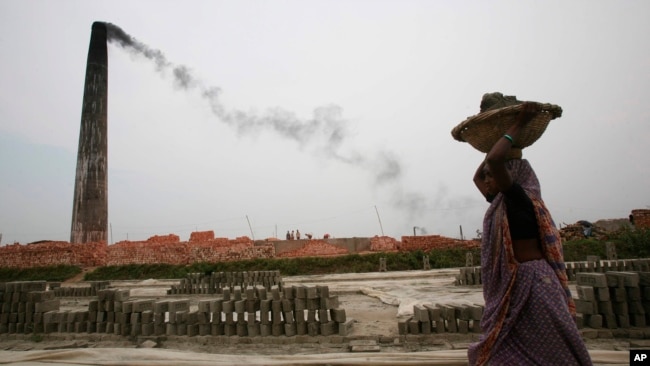PM2.5が我々を殺す恐怖
IQAirによると、日本は95か国中50位でした。(リアルタイム情報です)
下にURLを貼り付けています。ご参考までに。
ワースト1は、インド デリー
95位はカナダ バンクーバー
VOAでも何度も取り上げられている大気汚染でが、今回はIQAirによる最新報告。
今回もVOAで英語を学び、世界の今を見つめましょう!!
報告:南、中央アジアの人々は最も汚染された空気を呼吸している
Report: South, Central Asians Breathing Most Polluted Air
March 22, 2022
南アジアと中央アジアに住む人々は、世界で最も高いレベルの大気汚染に見舞われていることが、新しい研究で明らかになりました。
これらの地域の空気は、最も多くの種類の大気汚染物質が含まれています。PM2.5とは、直径2.5ミクロン以下の大気中の粒子状物質のことです。ミクロンは1メートルの100万分の1。PM2.5は非常に小さいので、人間の肺や血液の中に入り込むことができます。
スイスに本拠を置くIQAir社は、火曜日に最新の調査結果を発表しました。同社は大気質情報システムを運営しています。IQAirの年次報告は2017年から始まりました。
グローリードルフィン・ハメス氏は、IQAir North Americaのチーフを務めています。彼女はVOAに:「PM2.5は実際、他のどの大気質汚染物質よりも多くの人を殺しています。」と語ります。
IQAirの世界的なネットワークのデータによると、バングラデシュはPM2.5の大気汚染レベルが最も高い国です。また、チャド、パキスタン、タジキスタン、インドの5カ国は、大気質が最も低い国となっています。
IQAirの調べでは、インドのニューデリーが最もPM2.5汚染が進んでいる首都であることが判明しました。バングラデシュのダッカ、チャドのンジャメナ、タジキスタンのドゥシャンベ、オマーンのマスカットは、大気が極度に汚染されていると評価された他の首都です。
世界で最も空気がきれいなのは、フランスの海外領土であるニューカレドニア。ニューカレドニアの主要都市ヌメアは、IQAirによる空気のきれいさランキングでトップとなっています。
その他、カリブ海に浮かぶアメリカ領ヴァージン諸島やプエルトリコも空気がきれいな地域です。アフリカ沿岸の大西洋に浮かぶカーボベルデも、大気汚染が非常に少ないのです。
ドルフィン・ハメス氏によれば、発展途上国には十分なモニタリングが行われていない地域があるということです。それらの地域には、アフリカ、中東、南米の一部が含まれます。先進国は通常、発展途上国や地域よりも多くの大気質モニターを備えています。
いくつかの国では、モニタリングのレベルが過去数年よりも高くなっているといいます。その追加モニタリングにより、ドルフィン・ハメス氏は、「昨年のレポートにはなかった、最も汚染された国のうちの2カ国(チャド、タジキスタン)がある 」と指摘しています。
2021年、大気汚染レベルは1年前より上昇:COVID-19のパンデミックの最初の年です。2020年年、世界は地上と空からの輸送が減ったため、大気汚染は減少しました。昨年の大気汚染上昇のもうひとつの理由は、山火事の増加だとドルフィン・ハンメス氏は言います。
昨年、世界保健機関は、PM2.5の年間推奨値を1立方メートルあたり10マイクログラムから5マイクログラムへと半減させました。WHOは、この削減によって世界中で数百万人の死亡を防ぐことができると述べています。
科学者たちはこの新しい勧告を支持しました。しかし、科学者たちは、この勧告を達成するのが難しい国もあるだろうと心配しています。ロイター通信によれば、世界の多くの国はすでに10マイクログラムの制限値を達成できていないとのことです。
IQAirの年次報告は、現在117の国、地域、領土の合計6,475都市で測定されたPM2.5に基づいています。同社によると、世界中の情報は”何万もの規制および低コストの大気質監視ステーション”から得られています。これらの観測所は、政府、非営利団体、研究センター、市民科学者によって運営されています。
Report: South, Central Asians Breathing Most Polluted Air
A new study has found that people living in South and Central Asia experience some of the highest levels of air pollution in the world.
The air in these areas has the highest amounts of the most kind of air pollution. PM2.5 is atmospheric particulate matter that is 2.5 microns in diameter or less. A micron is one millionth of a meter. PM2.5 is so small that it can enter human lungs and the blood.
The Switzerland-based company IQAir released its latest study on Tuesday. The company operates an air quality information system. The yearly IQAir reports began in 2017.
Glory Dolphin Hammes is chief of IQAir North America. She told VOA: "PM2.5 actually kills more people than any other air quality pollutant.”
Based on data from IQAir’s worldwide network, Bangladesh is the country with the highest levels of PM2.5 air pollution. Chad, Pakistan, Tajikistan and India are also among the five nations with the lowest air quality.
IQAir found that New Delhi, India, is the capital city with the most PM2.5 pollution. Dhaka, Bangladesh; N'Djamena, Chad; Dushanbe, Tajikistan; and Muscat, Oman, are the other capital cities rated as having extremely polluted air.
People seeking the world’s cleanest air will find it in the French overseas territory of New Caledonia. The territory’s main city, Noumea, is at the top of IQAir’s clean air ranking.
Other places where the air is very clean include the U.S. Virgin Islands and Puerto Rico in the Caribbean. Cape Verde, in the Atlantic Ocean off the coast of Africa, also has very little air pollution.
Some parts of the developing world lack enough monitoring, Dolphin Hammes said. Those areas include parts of Africa, the Middle East and South America. Developed countries usually have a greater number of air quality monitors than developing countries and areas.
Monitoring is at a higher level than in past years in some countries, she said. With that additional monitoring, Dolphin Hammes noted, “there are two countries (Chad and Tajikistan) that are among the most polluted countries that weren’t on our report last year.”
In 2021, air pollution levels increased from those of a year earlier: the first year of the COVID-19 pandemic. In 2020, the world saw a decrease in air pollution because of less ground and air transportation. Another reason for the rise in air pollution last year was an increase in wildfires, Dolphin Hammes said.
Last year, the World Health Organization cut the recommended yearly PM2.5 limit by half – from 10 micrograms per cubic meter to five micrograms per cubic meter. The WHO said the reduction would prevent millions of deaths worldwide.
Scientists supported the new recommendations. But they worry that some countries would have trouble reaching them. Much of the world was already failing to meet the 10-microgram limit, Reuters news agency reported.
IQAir’s yearly reports are based on PM2.5 measurements from what is now a total of 6,475 cities in 117 countries, regions and territories. The worldwide information comes from "tens of thousands of regulatory and low-cost air quality monitoring stations,” the company said. The stations are operated by governments, nonprofit organizations, research centers and citizen scientists.
Words in This Story
diameter –n. the distance through the center of something from one side to the other
monitor –v. to watch, observe, listen to, or check (something) for a special purpose over a period of time
region –n. a part of a country or of the world, that is different or separate from other parts in some way
regulatory –adj. making or concerned with making official rules about what is acceptable in a particular business, activity or field
IQAirrランキング
アジア大気汚染リアルタイムMAP
東南アジアPM2.5の原因
https://www.irric.co.jp/pdf/risk_info/thailand/2020_03.pdf
Particulate matter 粒子状汚染物質 PM 空気中に浮遊する固体および液体粒子。
空気中に浮遊する固体および液体粒子。主要成分は、 硫酸塩、硝酸塩、アンモニア、塩化ナトリウム、ブラ ックカーボン、ミネラルダスト、および水。
ジャカルタの2019年における月ごとのPM2.5平均値を下図に示します。インドネシアでは主にカリマ ンタン島やスマトラ島などで乾季の4月から10月にかけて行われる野焼きにより煙霧(ヘイズ)が発生 し、PM2.5を含む粒子状汚染物質が増加します。また、ジャカルタ近郊には3,000万人以上が居住して おり、慢性的な交通渋滞や電力需要の増加(石炭火力発電所からの排煙)なども大気汚染の主要因に なっています。
ハノイ、ホーチミン共に、乾季の11月~1月にPM2.5の濃度が高くなる傾向にあります。石炭、石油消 費量の増加(過去5年間でベトナムの石炭消費量は2倍、石油消費量は3倍に増加)、旧式の自動車、 バイク利用者の増加、急速な都市化に伴う道路、建物、橋などの建設が主要因とされています。
バンコク(タイ)
バンコクのPM2.5観測値は乾季の12月、1月に急増する傾向があります。主な原因は自動車の排ガス (PM2.5の発生源に占める割合:約50%)、工場からの排出ガス(同:約30%)であり、12月~2月 にかけては雨がほとんど降らないこと、風がなく大気が循環しないことから、PM2.5の基準値を大きく 上回る日が散見されます。2019年、2020年年の1月にはPM2.5の観測値が危険な水準に達したとして学校を 休校にする措置が取られました。また、タイ北部では農地の野焼きによる大気汚染が深刻化しています。
たばこの煙と PM2.5
たばこの煙に含まれる粒子は典型的なPM2.5であり、屋内や車内で喫煙すると、デリー(インド)と 同等かそれ以上の濃度になります。日本禁煙学会の調査によれば、自由喫煙のパチンコ店で148 μg/m3 、 自由喫煙の居酒屋で568 μg/m3 、車内の喫煙では1,000μg/m3 以上に達するとの報告もあります。屋外の 大気汚染もさることながら、屋内、車内での喫煙はそれ以上に健康を害する危険性があります。
各国の対策
インドネシアのジャカルタ特別州では、2019年、大気汚染に対して政府が有効な対策を取っていな いとして環境保護団体が首相や州知事を提訴しました。同州では排気ガス測定器の設置、自動車の 排気ガス検査の義務化、公共バス「トランスジャカルタ」や高速鉄道(MRT)など公共交通機関の利 用促進などの対策が進められています。
ベトナムでは政府の主導で、大気汚染を削減するための公 的な助言、大気汚染の観測ネットワーク拡大、大気汚染指標の算出ガイドライン公開といった取組み が開始されており、重工業や発電所に対してより厳しい環境規制を適用する計画もあります。
タイのバンコクでは、PM2.5の観測値に応じて対策のレベルを4段階に設定しており、主要道路の清掃・ 水撒き、黒煙を排出する自動車の規制強化、建設作業の中止等の対策が政府や各行政単位の判断で実 施されます。
しかしながら、経済の発展と大気汚染の抑制を両立させることは難しく、今後しばらくの間は大気 汚染レベルの高い状態が継続するものと考えられます。公開されている大気汚染指標のチェック、外 出時のマスク着用(N95マスク)、空気清浄機の使用といった自衛策を取ることが重要です。
